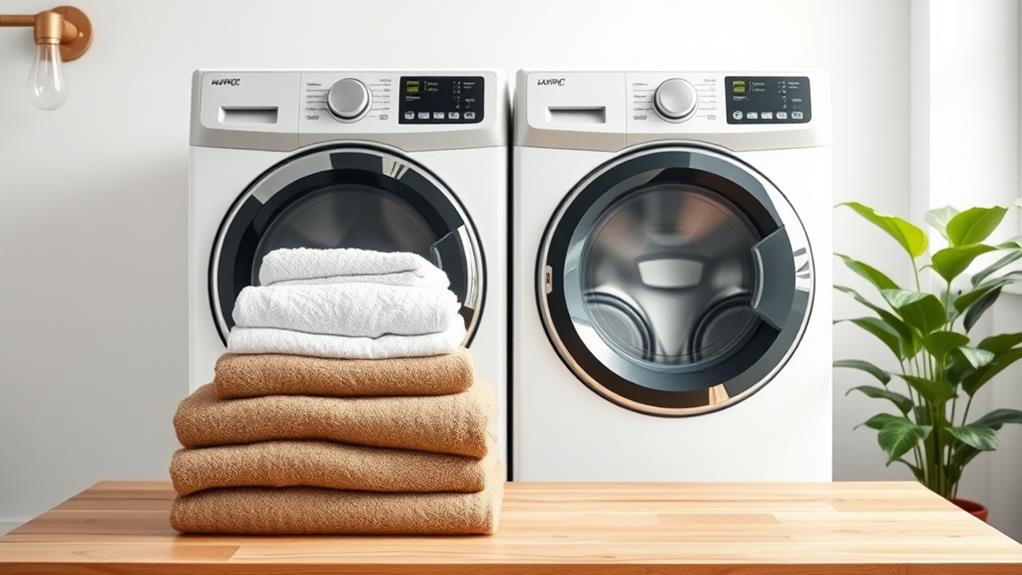To make your laundry routine more energy-efficient, start by investing in high-efficiency washers and heat pump dryers. These appliances use advanced technology to clean and dry clothes effectively while consuming less water and energy. Opt for cold water washing whenever possible, as it preserves fabric quality and reduces energy consumption. Use the right amount of HE detergent and optimize load sizes to maximize efficiency. Consider air-drying techniques and smart scheduling to further reduce energy use. By implementing these practices, you'll not only save on utility bills but also extend the life of your clothes and appliances. Discover even more ways to revolutionize your laundry routine and minimize your environmental impact.
High-Efficiency Washers
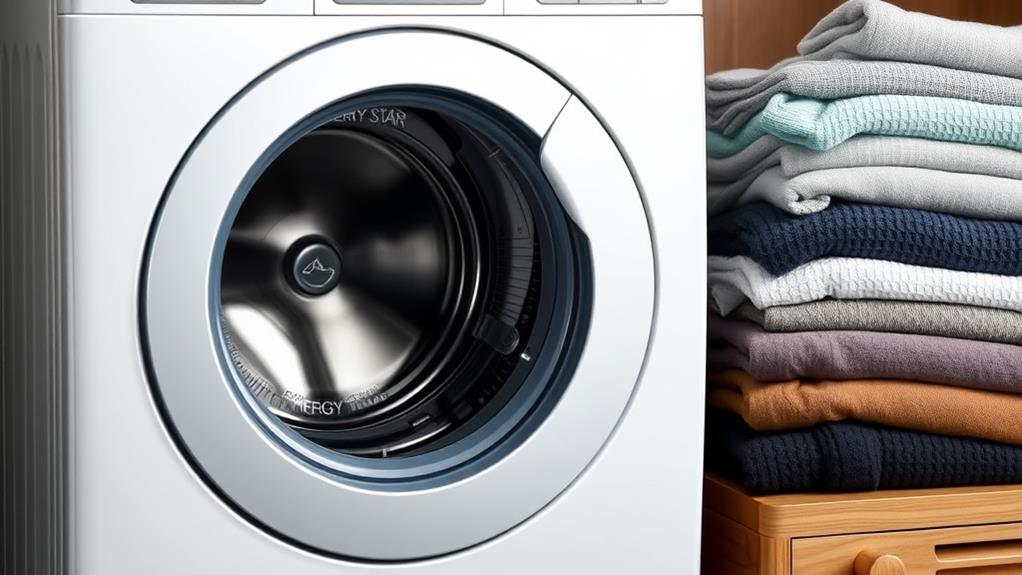
High-efficiency washers are a game-changer in energy-efficient laundry. These machines use less water and electricity than traditional models, saving you money on utility bills while reducing your environmental impact. They achieve this by utilizing advanced technology to clean clothes more effectively with fewer resources.
You'll notice that high-efficiency washers have a larger drum capacity, allowing you to wash more clothes in a single load. They also spin faster, extracting more water from your laundry and reducing drying time. Many models feature sensors that adjust water levels and wash cycles based on the size and soil level of each load, optimizing performance and efficiency.
When shopping for a high-efficiency washer, look for the ENERGY STAR label, which indicates the appliance meets strict energy efficiency guidelines. Front-loading models are typically more efficient than top-loaders, but both styles offer significant improvements over older machines. You'll need to use specially formulated HE detergent with these washers to prevent excess suds and ensure proper cleaning. While the initial cost may be higher, the long-term savings and environmental benefits make high-efficiency washers a smart investment for your home.
Heat Pump Dryers
From among the latest innovations in energy-efficient laundry, heat pump dryers stand out as a revolutionary option. These appliances use a closed-loop heat exchange system to dry your clothes, significantly reducing energy consumption compared to traditional dryers. You'll find that heat pump dryers can save up to 50% on your energy bills while being gentler on your clothes.
Unlike conventional dryers that expel hot, moist air, heat pump dryers recirculate it. They extract moisture from the air, condense it into water, and then reheat the air for continued use. This process allows them to operate at lower temperatures, protecting your garments from excessive heat damage.
You'll appreciate that heat pump dryers don't require external venting, making them ideal for apartments or homes with limited space. They're also compatible with a wider range of fabrics, including delicates. While the initial cost is higher than traditional dryers, you'll recoup the investment through long-term energy savings. Keep in mind that drying cycles may take longer, but the superior energy efficiency and fabric care make heat pump dryers an excellent choice for environmentally conscious consumers.
Cold Water Washing Benefits
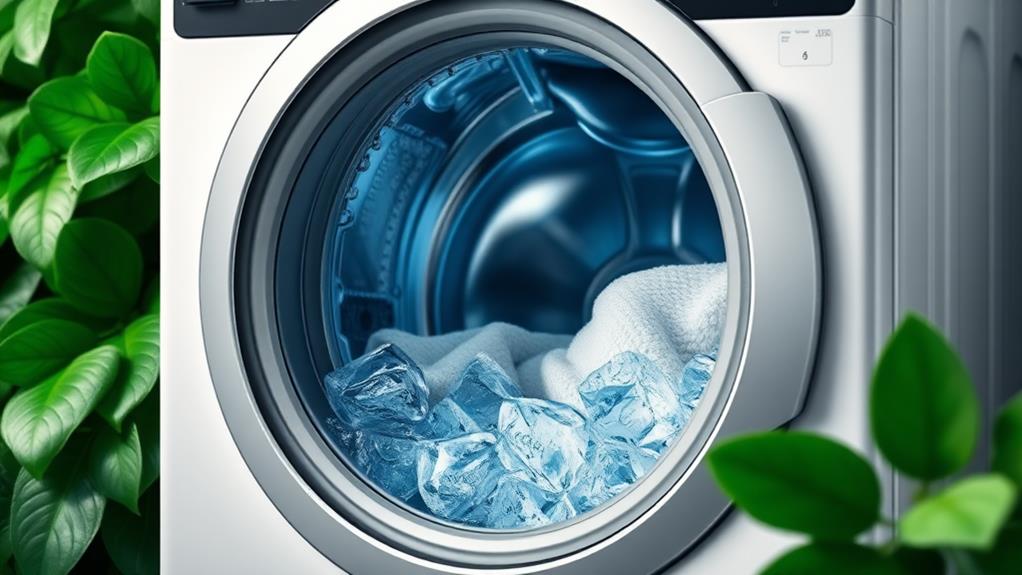
While heat pump dryers offer significant energy savings on the drying side, you can also make a big impact on your laundry's efficiency by focusing on the washing process.
One of the easiest ways to do this is by washing your clothes in cold water. Cold water washing has numerous benefits, both for your energy bill and your clothes.
First, you'll see a significant reduction in your energy consumption. Heating water for laundry accounts for a large portion of the energy used in washing machines. By switching to cold water, you can cut this energy use by up to 90%. This translates to lower utility bills and a smaller carbon footprint.
Cold water washing is also gentler on your clothes. It helps preserve fabric quality, prevents color fading, and reduces shrinkage. Many modern detergents are formulated to work effectively in cold water, so you won't sacrifice cleaning power. Additionally, cold water washing can help remove certain stains more effectively, as hot water can sometimes set protein-based stains.
You'll also find that cold water washing extends the life of your washing machine by reducing wear and tear on its components.
Proper Detergent Usage
When it comes to proper detergent usage, less is often more. Using too much detergent can lead to residue buildup on your clothes and inside your washing machine, potentially reducing its efficiency and lifespan. To determine the right amount, start with the manufacturer's recommendations and adjust based on your water hardness, load size, and soil level.
For high-efficiency (HE) washers, you'll need to use HE-specific detergents, which produce fewer suds and rinse out more easily. These machines require only about 1-2 tablespoons of detergent per load.
For standard washers, you'll typically use 1/4 to 1/3 cup of detergent.
Don't rely on the fill lines in detergent caps, as they often suggest more than necessary. Instead, measure your detergent carefully. If you notice suds remaining after the rinse cycle or your clothes feel stiff or itchy, you're likely using too much. Experiment with reducing the amount until you find the sweet spot for clean clothes without excess.
Consider using concentrated detergents, which require smaller amounts and reduce packaging waste. Finally, remember that fabric softeners aren't necessary for every load and can reduce the absorbency of towels and athletic wear.
Load Size Optimization
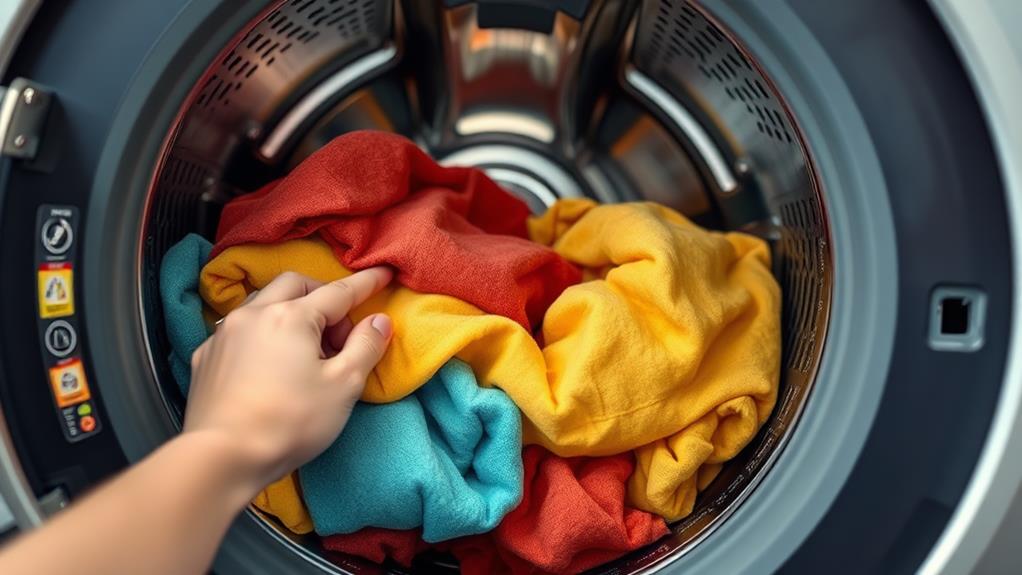
Optimizing load size is another key factor in energy-efficient laundry practices. You'll want to aim for full loads whenever possible, as this maximizes the use of water and energy per wash cycle. However, be careful not to overload your machine, as this can reduce cleaning effectiveness and potentially damage your clothes.
For top-loading washers, fill the tub about three-quarters full. With front-loaders, you can typically fill the drum up to the top, leaving a few inches of space. If you're unsure, check your machine's manual for specific guidance.
When you can't wait for a full load, use your washer's load size selector if available. This feature adjusts water levels to match smaller loads, saving resources. For dryers, it's equally important to avoid over-drying. Use moisture sensors if your dryer has them, or set the timer appropriately for the load size.
Air-Drying Techniques
Embrace air-drying as a highly effective energy-saving technique for your laundry routine. It's not only cost-effective but also gentle on your clothes, helping them last longer. To maximize efficiency, invest in a sturdy clothesline or drying rack.
For outdoor drying, choose a sunny, breezy spot to speed up the process. If you're drying indoors, ensure proper ventilation to prevent moisture buildup.
Organize your laundry strategically. Hang heavier items like towels and jeans on the outer edges of the line, where they'll catch more air and sun. Place lighter fabrics in the center. To prevent wrinkles, shake out clothes before hanging and smooth them with your hands. Use clothes pins or hangers to keep items in place and maintain their shape.
For delicate items, lay them flat on a clean towel or mesh drying rack. To expedite drying time, use a high-spin cycle in your washer to remove excess water. In humid climates or during winter, consider using a dehumidifier or fan to aid the drying process. By incorporating these air-drying techniques, you'll significantly reduce your energy consumption and extend the life of your garments.
Smart Laundry Scheduling
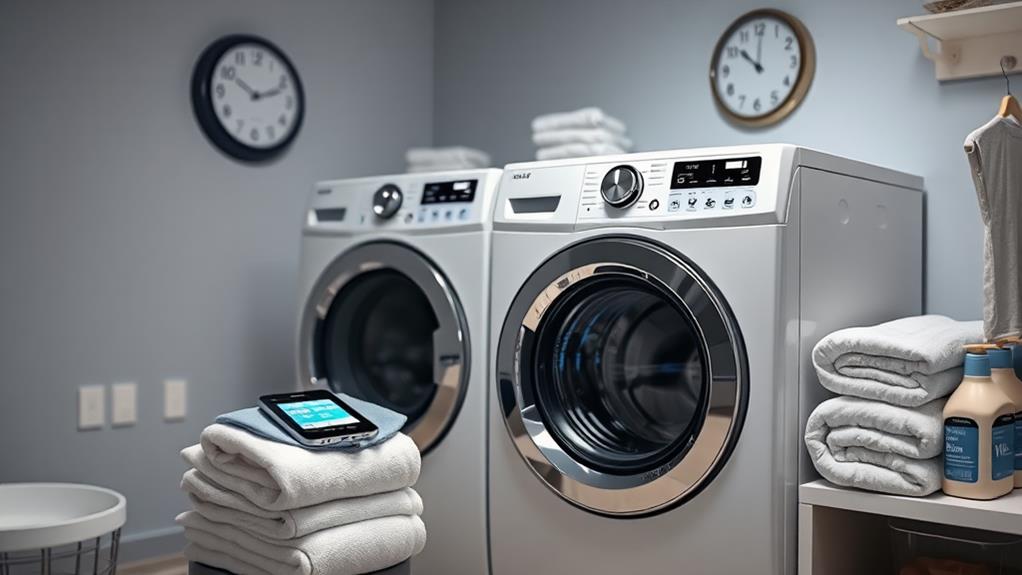
Through smart laundry scheduling, you can maximize energy efficiency and minimize your utility bills. Start by doing full loads whenever possible, as this reduces the number of cycles and saves both water and electricity. Aim to run your washer during off-peak hours, typically late at night or early morning, when energy demand is lower and rates may be cheaper.
If you have a smart meter or time-of-use pricing, take advantage of these features to determine the most cost-effective times to do laundry. Consider using delay start functions on your washer and dryer to automatically begin cycles during these optimal periods.
Group similar fabrics and soil levels together to avoid overworking your machines. Separate heavy items like towels from lighter ones to ensure even drying and prevent unnecessary extended cycles. If you're air-drying clothes, plan your washing schedule around weather forecasts to take advantage of sunny, breezy days.
Lastly, maintain a regular cleaning schedule for your washer and dryer. Clean lint filters after each use, and periodically clean the washer's drum and dryer vents. This upkeep ensures your machines operate at peak efficiency, saving energy with every load.
Conclusion
You've got the tools to revolutionize your laundry routine. By adopting energy-efficient appliances and smart practices, you'll slash your energy bills and reduce your environmental impact. Did you know that switching to cold water washing can cut your laundry's energy use by up to 90%? It's time to rethink your laundry habits. With these tips, you'll save money, energy, and the planet – all while keeping your clothes fresh and clean.
